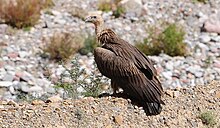Himalayan vulture
| Himalayan vulture | |
|---|---|
 |
|
| Scientific classification | |
| Kingdom: | Animalia |
| Phylum: | Chordata |
| Class: | Aves |
| Order: | Accipitriformes |
| Family: | Accipitridae |
| Genus: | Gyps |
| Species: | G. himalayensis |
| Binomial name | |
|
Gyps himalayensis Hume, 1869 |
|
 |
|
| Measurements | |||
|---|---|---|---|
| Length | 1,030–1,150 mm (40.6–45.3 in) | ||
| Culmen | 71–77 mm (2.8–3.0 in) | ||
| Wing | 755–805 mm (29.7–31.7 in) | ||
| Tail | 355–405 mm (14.0–15.9 in) | ||
| Tarsus | 110–126 mm (4.3–5.0 in) | ||
The Himalayan vulture or Himalayan griffon vulture (Gyps himalayensis) is an Old World vulture in the family Accipitridae. Closely related to the European griffon vulture (G. fulvus) and once considered a subspecies of it, this species is found along the Himalayas and the adjoining Tibetan Plateau. It is one of the two largest Old World vultures and true raptors.
This is a huge vulture and is perhaps the largest and heaviest bird found in the Himalayas. Adults have a ruff that is long and pale brown with white streaks. The ruff feathers are long and spiky. The head is covered in down which is yellowish in adults but whitish in immature vultures. The underside and under-wing coverts are quite pale brown or buff, being almost white in some specimens. The legs are covered with buffy feathers and the feet can vary from greenish grey to white. The upperside is unstreaked, pale buff with the tail quills, outer greater coverts and wing quills being a contrasting dark brown. The inner-secondaries have paler tips. The pale blue facial skin is lighter than the dark blue in Gyps fulvus with this species having a yellowish bill. In flight the long fingers are splayed and there is a pale patagial stripe on the underwing. The wing and tail feathers are dark and contrast with the pale coverts and body, one of the best methods to distinguish this species from the slightly smaller griffon vulture. The feathers on the body have pale shaft streaks. They are distinguished from the Indian vulture (G. indicus), which can somewhat similar in color by being much larger with a stouter, more robust bill. Younger birds have a pale parts to the bill and tend to have buffy-white streaks on the scapulars and wing coverts contrasting with dark brown underparts. They are similar in size to the cinereous vulture (Aegypius monachus), which has a slightly shorter overall length but in large specimens can weigh more than the Himalayan vulture. Weight in Himalayan vultures can range from reportedly as little as 6 kg (13 lb) to as much as 12.5 kg (28 lb). A field study estimated an average of 9 kg (20 lb) for the Himalayan vulture, but weights can vary with conditions from 8–12 kg (18–26 lb). The wingspan of birds varies greatly depending on the method used to measure them and published measurements vary from 2.56 to 3.1 m (8.4 to 10.2 ft), a similar wingspan range as a cinereous vulture.
...
Wikipedia

